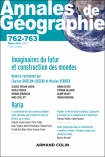
ANNALES DE GÉOGRAPHIE - N° 745 (3/2022)
Pour acheter ce numéro, contactez-nous
Recevez les numéros de l'année en cours et accédez à l'intégralité des articles en ligne.
Tout en s’inscrivant dans une dimension résolument locale, puisqu’il considère le quotidien des habitants d’une île située au sud de la Sicile, Fuocoammare était présenté à sa sortie en 2016 comme un film visant à mobiliser les consciences politiques au niveau européen. C’est en effet de Lampedusa qu’il y est question et ce documentaire de Gianfranco Rosi a rencontré un écho important. L’île y est à la fois point névralgique des flux migratoires et placée à l’écart du Monde. Cet article examine les choix formels, de montage en particulier, à travers lesquels le film creuse cette contradiction pour pointer les effets d’une certaine forme de frontière depuis le lieu qu’il observe. Son objectif est de mettre ainsi en lumière l’imaginaire ambivalent de l’insularité que mobilise pour ce faire le documentaire, y compris en croisant son analyse avec celle du film de fiction Terraferma (Emanuele Crialese, 2011) qui proposait une approche très différente du même territoire.
Although it has a resolutely local dimension, since it considers the daily life of the inhabitants of an island located in the south of Sicily, Fire at Sea (Fuocoammare) was presented at its release in 2016 as a film aiming to mobilize political awareness at European level. It is indeed about Lampedusa and this documentary by Gianfranco Rosi has met with a great response. The island appears to be both a nerve center of migratory flows and at the same time an out-of-the-way place in the world. This article examines the formal choices, in particular the editing, through which the film exploits that contradiction to point out the effects of a certain form of border from the place it observes. Its aim is to highlight the ambivalent imaginary of insularity that the documentary mobilizes to do this, including by crossing its analysis with that of the fiction film Terraferma (Emanuele Crialese, 2011), which proposed a very different approach to the same territory.

